- Clone
- BA5b (See other available formats)
- Regulatory Status
- RUO
- Workshop
- VI N-L078
- Other Names
- ADA-binding protein, DPP IV ectoenzyme, EC 3.4.14.5
- Isotype
- Mouse IgG2a, κ
- Ave. Rating
- Submit a Review
- Product Citations
- publications
CD26 is a 110 kD type II membrane protein also known as ADA-binding protein and dipeptidyl peptidase IV (DPPIV). It is a member of the peptidase and ectoenzyme family. CD26 is expressed on the membrane of mature thymocytes, T lymphocytes (upregulated upon activation), B cells, NK cells, and macrophages. CD26 cleaves off N-terminal X-Pro and X-Ala dipeptides from polypeptides. It plays an integral role as a costimulatory molecule in T cell activation. CD26 may interact with extracellular matrix proteins such as fibronectin or collagen, CD45 and ADA.
Product DetailsProduct Details
- Verified Reactivity
- Human
- Antibody Type
- Monoclonal
- Host Species
- Mouse
- Formulation
- Phosphate-buffered solution, pH 7.2, containing 0.09% sodium azide
- Preparation
- The antibody was purified by affinity chromatography and conjugated with Spark Red™ 718 under optimal conditions.
- Concentration
- 0.2 mg/mL
- Storage & Handling
- The antibody solution should be stored undiluted between 2°C and 8°C, and protected from prolonged exposure to light. Do not freeze.
- Application
-
FC
- Recommended Usage
-
Flexi-Fluors™ are provided at a standard 0.2 mg/mL concentration. We recommend titrating this reagent to determine the optimal concentration for each application. For many flow cytometry applications, conjugated antibodies perform well at concentrations ranging from 0.03 to 1.0 µg per million cells in 100 µL. We recommend testing a range of concentrations starting from 10 µg/mL.
For example, make five 1:1 serial dilutions of the 0.2 mg/mL antibody. Add 5 µL of each dilution (including the undiluted antibody) to 100 µL of cells (at 107 cells/mL) to test six concentrations -- 1.0, 0.5, 0.25, 0.125, 0.06, and 0.03 µg per million cells in 100 µL volume. Compare staining patterns or create a titration curve using the MFI or staining index to determine the optimal concentration.
* Spark Red™ 718 has a maximum excitation of 697 nm and a maximum emission of 711 nm. - Excitation Laser
-
Red Laser (633 nm)
- Additional Product Notes
-
For more information about Flexi-Fluors™, visit our Flexi-Fluor™ page and review FAQs associated with this product line.
- Application References
-
- Kishimoto T, et al. Eds. 1997. Leucocyte Typing VI. Garland Press. London.
- Schlossman S, et al. Eds. 1995. Leucocyte Typing V. Oxford University Press. New York.
- RRID
-
AB_3106322 (BioLegend Cat. No. 285061)
Antigen Details
- Structure
- Peptidases and ectoenzyme families, type II glycoprotein, 110 kD
- Distribution
-
Thymocyte subset, memory T cells, B cells, NK cells, epithelial cells, macrophages
- Function
- Dipeptidyl peptidase, T cell costimulation, HIV entry
- Ligand/Receptor
- Adenosine-deaminase, collagen
- Cell Type
- B cells, Epithelial cells, Macrophages, NK cells, T cells, Thymocytes
- Biology Area
- Costimulatory Molecules, Immunology
- Molecular Family
- CD Molecules
- Antigen References
-
1. Kameoka J, et al. 1993. Science 261:466.
2. Dang N, et al. 1990. J. Exp. Med. 172:649. - Gene ID
- 1803 View all products for this Gene ID
- UniProt
- View information about CD26 on UniProt.org
Related FAQs
- What are Flexi-Fluors?
-
Flexi-Fluors are rapidly made-to-order conjugated antibodies. The technology, manufacturing processes, and specifications used to create Flexi-Fluors are the same as our regular catalog products. However, the optimal concentration and performance of each Flexi-Fluor must be determined by the customer.
- How quickly will I receive my order?
-
We aim to ship Flexi-Fluors within 2-3 weeks of receipt of your order. However, depending on your location, shipping times may vary.
- How are Flexi-Fluors different from regular catalog products?
-
Flexi-Fluors are made on demand, specifically for you. Flexi-Fluors are manufactured using the same high-quality standards, and specifications as other catalog products. For faster delivery, Flexi-Fluors are not tested by flow cytometry to determine optimal concentrations or evaluate performance. This testing needs to be performed by the customer.
- How do I determine the optimal concentration for using my Flexi-Fluor? How should I titrate my antibody?
-
Flexi-Fluors are provided at a standard 0.2 mg/mL concentration. We recommend that you titrate your antibody to determine the optimal concentration to use for your application. For many flow cytometry applications, conjugated antibodies perform well at concentrations ranging from 0.03 to 1.0 µg per million cells in 100 µL volume. We recommend that you test a range of concentrations starting from 10 µg/mL.
For example, make five 1:1 serial dilutions of your 0.2 mg/mL antibody. Add 5 µL of each dilution (including the undiluted antibody) to 100 µL of cells (at 107 cells/ml) to test six concentrations - 1.0, 0.5, 0.25, 0.125, 0.06, and 0.03 µg per million cells in 100 µL volume. Compare staining patterns or create a titration curve using the MFI or staining index to determine the optimal concentration.
- I can’t find the antibody-dye combination that I need. When will it be available?
-
We continuously update our catalog, introducing scores of new products every month. Please get in touch with our Technical Service team for an update on new products or recommendations for suitable alternatives to complete your panel. Or contact Custom Solutions to inquire about our affordable custom conjugation services.
- I need help to validate the performance of my Flexi-Fluor. Who should I contact?
-
Please get in touch with Technical Service for assistance.
- Can I order more than 50 μg of a Flexi-Fluor?
-
Yes, you can order multiple vials of the same Flexi-Fluor products. We cannot guarantee, however, that these vials will be bottled from the same lot. For bulk single-lot orders, contact our Custom Solutions team.
- What is the expiration date of my Flexi-Fluor?
-
Expiration dates can be found on the vial label or by using our CoA lookup tool.
Other Formats
View All CD26 Reagents Request Custom Conjugation| Description | Clone | Applications |
|---|---|---|
| FITC anti-human CD26 | BA5b | FC |
| PE anti-human CD26 | BA5b | FC |
| PE/Cyanine5 anti-human CD26 | BA5b | FC |
| Purified anti-human CD26 | BA5b | FC |
| APC anti-human CD26 | BA5b | FC |
| PE/Cyanine7 anti-human CD26 | BA5b | FC |
| PerCP/Cyanine5.5 anti-human CD26 | BA5b | FC |
| Biotin anti-human CD26 | BA5b | FC |
| TotalSeq™-A0396 anti-human CD26 | BA5b | PG |
| TotalSeq™-C0396 anti-human CD26 | BA5b | PG |
| KIRAVIA Blue 520™ anti-human CD26 | BA5b | FC |
| TotalSeq™-B0396 anti-human CD26 | BA5b | PG |
| TotalSeq™-D0396 anti-human CD26 | BA5b | PG |
| FITC anti-human CD26 | BA5b | FC |
| PE anti-human CD26 | BA5b | FC |
| PE/Cyanine7 anti-human CD26 | BA5b | FC |
| Spark Red™ 718 anti-human CD26 (Flexi-Fluor™) | BA5b | FC |
| GMP FITC anti-human CD26 | BA5b | FC |
| GMP PE anti-human CD26 | BA5b | FC |
Compare Data Across All Formats
This data display is provided for general comparisons between formats.
Your actual data may vary due to variations in samples, target cells, instruments and their settings, staining conditions, and other factors.
If you need assistance with selecting the best format contact our expert technical support team.
-
FITC anti-human CD26
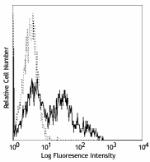
Human peripheral blood lymphocytes stained with BA5b FITC -
PE anti-human CD26
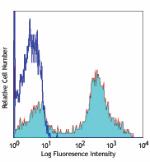
Human peripheral blood lymphocytes stained with BA5b PE -
PE/Cyanine5 anti-human CD26
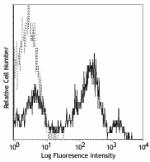
Human peripheral blood lymphocytes stained with BA5b PE/Cyan... -
Purified anti-human CD26

Human peripheral blood lymphocytes stained with BA5b PE/Cyan... -
APC anti-human CD26

Human peripheral blood lymphocytes were stained with CD26 (c... -
PE/Cyanine7 anti-human CD26
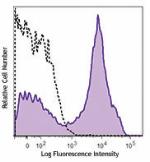
Human peripheral blood lymphocytes were stained with CD26 (c... -
PerCP/Cyanine5.5 anti-human CD26
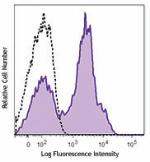
Human peripheral blood lymphocytes were stained with CD26 (c... -
Biotin anti-human CD26
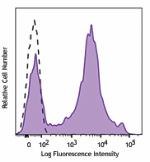
Human peripheral blood lymphocytes were stained with biotiny... -
TotalSeq™-A0396 anti-human CD26
-
TotalSeq™-C0396 anti-human CD26
-
KIRAVIA Blue 520™ anti-human CD26

Human peripheral blood lymphocytes were stained with CD3 APC... -
TotalSeq™-B0396 anti-human CD26
-
TotalSeq™-D0396 anti-human CD26
-
FITC anti-human CD26
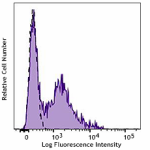
Typical results from human peripheral blood lymphocytes stai... -
PE anti-human CD26
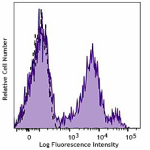
Typical results from human peripheral blood lymphocytes stai... -
PE/Cyanine7 anti-human CD26

Typical results from human peripheral blood lymphocytes stai... -
Spark Red™ 718 anti-human CD26 (Flexi-Fluor™)
-
GMP FITC anti-human CD26

Typical results from human peripheral blood lymphocytes stai... -
GMP PE anti-human CD26

Typical results from human peripheral blood lymphocytes stai...
 Login / Register
Login / Register 













Follow Us